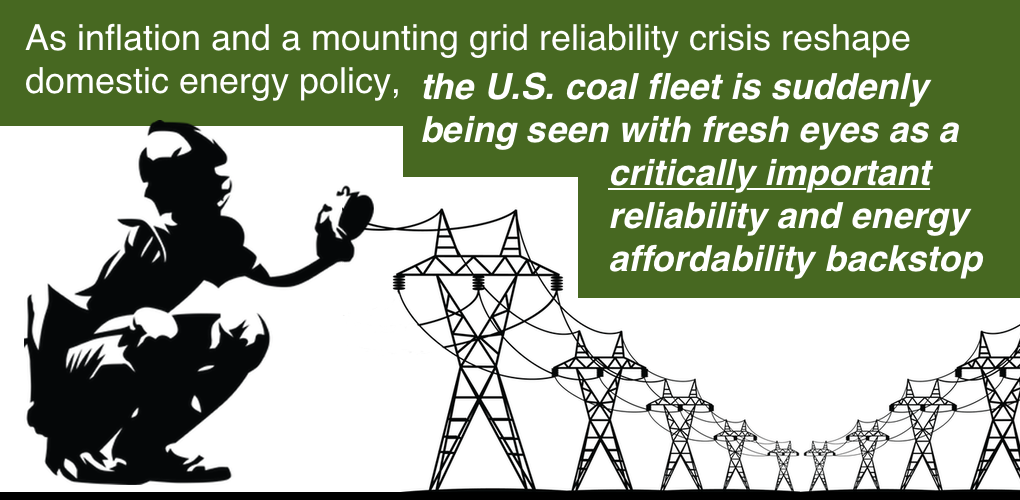
Coal Remains Globally Essential
Perhaps The Economist announcing an “end to coal” last year was just a bit premature. As The Wall Street Journal just reported, from Asia to Europe and the U.S., coal is once again having a moment. Energy shortages, rediscovery of the importance of energy security and energy-driven inflation are all driving a new, voracious appetite for a fuel that keeps being written off by the Davos jet-set and keeps being found irreplaceable by anyone tasked with keeping the lights on and the engines of industry turning.
Even for nations that have announced a hard end to their use of coal, pragmatism is winning the day. As one international energy observer told The Journal, “Right now the sentiment is that more coal is better than more Russia.” Coal imports to key a hub in Europe are up 35% year over year.
Certainly, the war in Ukraine and Europe’s race to replace Russian energy is driving Europe’s reembrace of coal, but coal’s moment shouldn’t just be attributed to geopolitics and war. Coal’s renewed importance (though global data would indicate its importance hardly faded) is about other important trends as well. Supply chain shocks for renewable energy, electrification and the myriad challenges of the energy transition are all developments that shouldn’t be overlooked. That’s certainly the case here in the U.S.
The Reliability Backstop
As inflation and a mounting grid reliability crisis reshape domestic energy policy, the U.S. coal fleet is suddenly being seen with fresh eyes as a critically important reliability and energy affordability backstop.
With regional grids short capacity – namely dispatchable, fuel-secure generating capacity – coal plants scheduled for retirement or conversion are getting a second lease on life. The Omaha Public Power District announced on June 16 that it is proposing to delay conversion of its North Omaha Station coal units citing a range of supply chain challenges. Northern Indiana Public Service Company is delaying the retirement of its Schahfer Generating Station, citing delays in standing up several solar projects. And Alliant Energy in Wisconsin is bumping back the closure of two of its coal plants due to supply chain constraints and concern the Midwest is painfully short of needed peak generating capacity. These are just a few examples of a national trend.
While these announcements have drawn considerable attention, they aren’t the best indicator of coal’s overlooked importance. It’s rather the threat of accelerated coal plant closures from a suite of U.S. Environmental Protection Agency (EPA) rules shining new light on the essential role coal capacity continues to play in anchoring the grid across much of the country.
Catastrophic Consequences for the Grid
In comments to EPA, utilities and grid operators are warning of severe reliability challenges should EPA press forward with several rules they deem to be simply unworkable. From the Coal Combustion Residuals Rule to the Cross-State Air Pollution Rule (CSAPR), the effect will be dozens of near-immediate plant closures.
In fact, utilities and even some labor unions noted in comments to EPA that by the agency’s own calculations, the CSAPR proposal alone would result in more power plant retirements than any previous EPA regulation.
The Midcontinent Independent System Operator, which operates the grid for much of the Midwest and is already facing alarming reliability challenges, bluntly told EPA its CSAPR proposal isn’t compatible with maintaining reliability. PJM Interconnection, which manages the nation’s largest grid stretching across the Mid-Atlantic through Ohio, agreed, telling EPA, “implementation of the Proposed Rule has the potential to pose distinct reliability challenges that must be addressed.”
The Electric Reliability Council of Texas (ERCOT), the state’s grid operator which has already faced catastrophic reliability challenges, told EPA the forced retirement of coal-fired generation “would pose a serious threat to the reliability of the ERCOT electric transmission system…” ERCOT added, “[EPA’s] mandates could have catastrophic consequences for the electric grid.”
All three grid operators have endorsed the creation of a reliability safety valve (RSV) to keep plants operating and to create targeted exclusions from the rule to ensure operators have the capacity they need to manage the energy transition. Even PJM, which isn’t facing the same reliability challenges as MISO or ERCOT, strongly supports an RSV, telling EPA, “Although PJM today has an adequate reserve margin, the region is not immune from the trends occurring elsewhere in the country that have driven premature retirement of fossil resources at the very time when such resources will be needed as a back-up given the intermittent nature of renewable resource output.”
It’s past time U.S. policymakers embrace what our grid experts are saying: the coal fleet and our coal producers remain essential pieces of the nation’s energy system. In fact, coal remains an essential piece of the world’s energy system, a critically important tool to provide energy security and underpin energy affordability the world over. We cannot and should not underinvest in or dismantle the fuels and energy infrastructure needed to get us to a reliable and affordable energy future.
- On July 6, 2022
